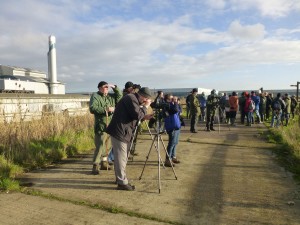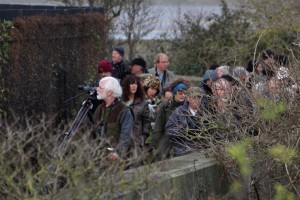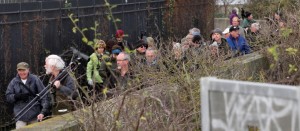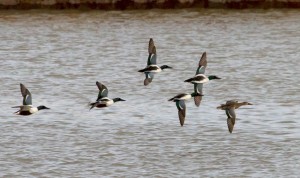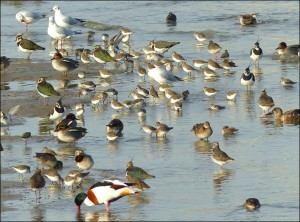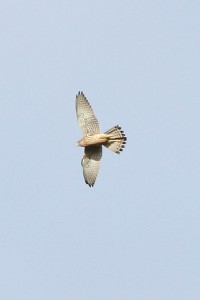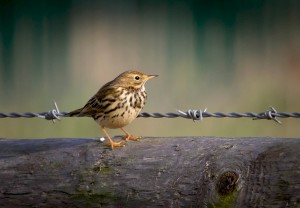This event proved to be one of the most popular bird walks at Crossness on Erith Marshes, with 37 members and friends turning out to enjoy this great reserve.
The recent history of Friends events at Crossness – especially where birdwatching is concerned has been one of inclement weather to say the least. We weren’t very optimistic for our first walk of 2016 having experienced possibly the wettest December/early January in recent times – so with rain still falling into the early hours we felt really blessed that as we assembled it was dry and someone must have been looking after us as it stayed that way all morning though very, very soggy underfoot.
Thirty seven is a lot of people to show wildlife to but undeterred we wandered up to the River Thames.
Given that high tide was only two hours away, we wanted to see any exposed mud that might still be visible – not much as it happened but the sun was shining and the light on the gathered wildfowl showed them at their absolute best. Forty plus wigeon with their silver grey flanks, rufous head and buff/yellow forehead, 50+ shoveler – surely one of the most attractive ducks and my own “second” favourite – the gadwall were all gathered around the outfall to enjoy the feast that this area provides.
Hundred plus teal, looking equally wonderful, were closer to shore along with a few mallard, a couple of shelduck and cormorants. Half an hour later and everyone had had good views and been able to ID this wonderful array of wildfowl. Some were lucky enough to see a kingfisher whizz past (one had already been seen on the walk up as it flew across the path from the wader scrape to the west paddock). A grey wagtail fed on the shoreline and up to five snipe were skulking amongst the rocks but many of the group managed good views and even some photographs. A distant flock of dunlin swirled around and a few redshank were seen before disappearing as the tide rose. Similarly a flock of lapwing were flying around flapping their wings like dropped dusters.
We returned to the reserve where bird life reflected many recent reports from across the country – the winter influx normally experienced just doesn’t seem to have happened this year – few birds in many gardens, likewise in the wider environment. We kept eyes open whilst enjoying a great social occasion and at the same time learning more about the reserve. A male marsh harrier was spotted in the south west corner and we watched it until it disappeared high and south. A kestrel hovered over and three little grebes were seen on the Great Breach.
There were of course a range of common species – not least moorhen and coot, a Cetti’s warbler was heard. As we arrived at the eastern end of the reserve, we were able to see first-hand the eyesore of the new warehouse (one of three) being erected to the east of Norman Road field (former site of an electric sub-station) and were able to imagine what this wonderful area would look like if any further development happened on the Cory/Borax fields as is widely thought likely – the meadows pipits and pair of stonechat we enjoyed watching just might not have the right habitat to feed on in future. The kestrel hovering over the same fields might also find its food in shorter supply.
So, as time marched on, we marched back to the Hide for one of Karen’s “spreads” and over lunch there was much chat amongst members and friends and another wonderful morning had been enjoyed.
Species seen/heard: Little grebe – 3, cormorant – a few on the river, grey heron – 1 as we were retiring for lunch! shelduck – a few on the river, wigeon – 40+ on river, gadwall – 50+ on river, teal – 100+ on river and a few on great breach, mallard – surprisingly few, shoveler – 20-30 on river, marsh harrier, kestrel – 3-4, pheasant – one male, moorhen – 20+,coot, lapwing – c100, dunlin – 3-400 in large distant flock – a few small flocks flying up river, snipe – 5-6 foreshore, redshank – dozen or so on river, black headed gull, lesser black-backed gull, woodpigeons, kingfisher – west paddock/river, green woodpecker – west paddock, meadow pipit – 5-6 Norman road/Borax fields, grey wagtail – river, wren, stonechat – pair Norman road/borax, blackbird, Cetti’s warbler heard, blue tit, great tit, magpie, carrion crow, starling, chaffinch – one female, linnet – flock of c20, reed bunting – 2 female. 37 in total
Karen Sutton, Ralph and Brenda Todd

